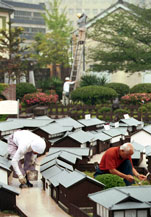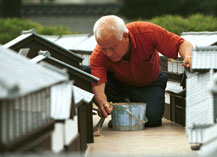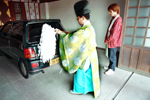Covering
Japan: Nagasaki Journal |
The Students
The Classes
Historic
Port a Link to West
An Island Enclave of Dutch Traders Returns to Life as Tourist Attraction
By Austin Ramzy
Special to the Mercury News
(This story originally appeared in the San Jose Mercury
News on August 8, 2002. Click here
to view it on the Mercury News web site)
NAGASAKI, Japan – The piece of downtown called Dejima is just a
city block easily obscured by nondescript
office buildings. For more than 200 years, however, it was a special place
in Japan – an island built off the city's shoreline to both welcome
the outside world and keep it at bay.
 Akinori Furusato, left, and Haruo Furusato repaint the one-fifteenth-scale model of Dejima island, the 17th century Dutch trading post off Nagasaki. The island has been surrounded by landfill. |
Now, atop the stone foundations of a
place once used to exclude foreigners, Nagasaki plans to spend $130 million
to recreate the island gateway to entice the world to its door.
Created in the early 17th century, Dejima was a fan-shaped patch of land
close to the Nagasaki shore, but it disappeared after Japan was forced
open following the 1853 arrival of American Commodore Matthew Perry. Dutch
traders, who had been confined to the island since 1641, were free to
move elsewhere. Other trading ports opened, and by 1904 harbor reclamation
projects in Nagasaki had swallowed Dejima.
None of the isolation-period buildings survives, but a half-dozen replicas
have been built in the style of the early 1800s. Junior high school students
on educational trips pile out of taxis to visit them. Drivers in captain's
hats and red vests give quick tours to the children in blue-and-white
uniforms. They remove their shoes while inspecting a restored captain's
quarters, a Japanese formality the Dutch probably never followed, said
curator Miyuki Takada.
On a hot weekday afternoon, Miyuki Fujimoto, a 36-year-old teacher from
Shikoku Island, sat in the shade tapping e-mail messages on her cellular
phone while her eighth-grade students tromped around Dejima. The focus
of their class visit to Nagasaki was to see the sites commemorating the
atomic bomb dropped here by the Americans at the end of World War II.
Dejima is just a checkpoint on the Nagasaki tourist trail, Fujimoto said.
"It is a famous place," she said. "But I think some of
the students feel bored."
Yoshimitu Tanemura, a Dejima restoration official, said he sees some irony
in trying to bring people to a place that was once designed to keep them
out.
But Isabel van Daalen, a researcher with the Japan-Netherlands Institute
in Tokyo, said the island was always a tourist attraction. "It was
the only place you could see foreigners," she said. "In the
diaries of the Dutch, it said that the Japanese would come to look and
when the Dutch went out there were crowds gathered to look at them, the
children peeking out."
On spring weekdays, scores of young students now visit. They stand next
to a one-fifteenth-scale model of the island and are quick to include
in their photographs any foreigner who might be standing nearby. The Dutch
are no longer around, but the young visitors are still curious to see
people from abroad. "If there are foreigners here, we want to speak
with them," said 15-year-old Mari Toyoto.
Nagasaki is known around the world as
the target of the second atomic bomb. But this city of 430,000 sees itself
as an international gateway, closer to the South Korean city of Pusan
and China's Shanghai than to Tokyo. A museum is dedicated to the bombing
with frank descriptions of the aftermath, but official tourist brochures
awkwardly sandwich the topic between descriptions of a cosmopolitan city,
Japan's sole window to the outside during the period of national isolation.
From 1639 to 1854, Japan maintained ties with just Holland, China and
Korea, a period known as sakoku, or "closed country." Nagasaki,
on Japan's southern island of Kyushu, was the center of the country's
limited contact with the outside world.
 |
"During the isolated period, Nagasaki
was given special rights to trade with the Dutch," said Miyuki Takada,
a Dejima curator. "From that aspect Dejima has significance, not
just because of trade, but because it's the only place where Western culture,
Western technology and Western thinking entered Japan. The restoration
is important because Nagasaki wants to retain its connection with the
outside world, its significance as a cosmopolitan city."
Tokugawa Iemitsu, the military ruler of Japan, ordered the island's construction
in 1634 to intern Portuguese traders. They were expelled from the country
five years later because of fears of Christian influence. The Dutch were
isolated at Dejima after the Portuguese left.
The Dutch East India Company mainly imported Chinese silk through the
island, but their ships also carried European fabrics, spices, drugs and
jewelry to Japan. They left with gold, silver and copper. The goods were
carried across a short bridge to the mainland; Japanese guards closely
watched the gate. At first several ships came each year, but the trade
decreased as Japanese regulations made it less profitable for the Dutch.
Along with goods came knowledge. Upon arriving, a new Dutch director was
required to tell his Japanese interpreters about world developments. This
information increased the shogun's limited news from outside Japan. The
Dutch made annual visits to the capital of Edo, which increased Western
knowledge of Japanese history, culture and geography.
The Dutch also brought Western medicine, technology and science. The study
of this outside knowledge was known as rangaku, or Dutch learning.
"Dejima served as a place to import many things from abroad. If not
for this place, Japan would have been very far behind at the end of the
19th century," said Narimasa Imanaga, a 55-year-old tourist, as he
sat with his wife under a trellis of five-leaf akebi. The vine was shipped
to Europe in the 19th century by Philip Franz von Siebold, a German doctor
on Dejima who expanded opportunities to study Western medical techniques
in Japan.
After Japan opened other ports to the West in 1859, Dejima became part
of Nagasaki's foreign enclave. An international club and an Anglican seminary
were built. Both buildings still stand; the blue clapboard seminary houses
a Dejima museum while the green-and-yellow international club holds other
exhibits.
The restoration efforts began shortly after World War II at the urging
of the Dutch, said Tanemura, the restoration official. The first land
was purchased in 1951, but work on new buildings didn't get under way
for almost half a century.
Reconstruction of Dejima has been slowed by a stagnant economy, the detailed
process of documenting the appearance of structures that disappeared a
century ago and difficulties in buying land on the site, restoration officials
said.
The discovery of old stone walls helped pinpoint the island's borders.
Half the restoration budget was used to buy the land where the island
once stood.

